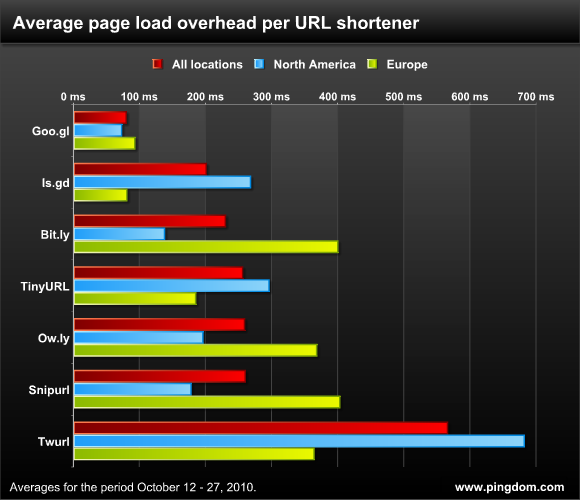来自: royal.pingdom.com – FeedzShare
发布时间:2010年10月29日, 已有 5 人推荐

A few weeks ago, Google made its URL shortener, Goo.gl, open for everyone and gave it its own website, similar to Bit.ly’s. Previously, Goo.gl could only be used by Google’s own services.
When they announced this, Google made a pretty bold statement: “… we do want it to be the stablest, most secure, and fastest URL shortener on the web.”
That’s something that we should test, isn’t it?
So, for a couple of weeks after Goo.gl became open, we monitored its performance and reliability together with several other URL shortening services, including Bit.ly and TinyURL. We used, of course, our own monitoring service (i.e. Pingdom).
Testing what matters
We were primarily concerned with the reliability and performance of shortened URLs. How much overhead do the different URL shorteners add, and do they always work? What you are ultimately comparing is the time it takes to go to a site directly versus the time it takes to go to that site via a URL shortener.
Note that we only included “open” URL shorteners like Bit.ly and Goo.gl that let you create your own short URLs (just visit their site, enter a long URL, and get a short one back). There are lots of application-specific URL shorteners like Twitter’s t.co, WordPress.com’s wp.me, etc, that don’t let you do this. We didn’t include those since we wanted to test comparable services.
Since we used the Pingdom monitoring network, the continuous tests were spread out over 25 locations distributed over North America and Europe. We performed tests every minute for 15 days. For those of you counting, that means that the numbers we’ll show you are the result of 21,600 tests per URL shortener.
Performance overhead
The overhead that an URL shortener adds is that, instead of going directly to a site, you first have to ask the servers of the URL shortening service where to go, and they will redirect you to the actual target site.
As you’ll see, how much overhead this adds can vary a lot not just between different URL shorteners, but also between different geographical regions.
To be perfectly clear, what you see in the chart here below is the extra time a URL shortener adds when accessing a site. We’ve sorted the list so that the fastest total average it at the top, the slowest at the bottom.

A few observations:
- Since people like to compare Goo.gl specifically with Bit.ly, it turns out that Goo.gl is almost 3x faster than Bit.ly overall, at least during the time period of this test. The really big difference, however, is outside North America, where Goo.gl is more than 4x faster. We attribute this to Google simply having more servers in more locations, which of course is to be expected considering how many data centers the company has. In North America the difference is less pronounced, where Goo.gl is 2x faster on average. The difference is less here because it’s where Bit.ly has its servers.
- The only place Goo.gl was beat was in Europe, where Is.gd actually managed to inch just ahead of it in terms of performance. That said, Goo.gl is still 2.5x faster than Is.gd in North America. It’s pretty safe to say that Is.gd has its servers in Europe.
- The most drastic difference in the test was between the European results for Goo.gl and Twurl, where the former was more than 9x faster. So there you have a worst-case scenario of how much the performance can differ between two services.
Small note for clarity’s sake: When we say for example “2x faster,” we mean the same thing as “adds half as much overhead.”
Reliability
It doesn’t matter how fast a URL shortener is if it’s broken. That’s why we thought it was relevant to also show the reliability of the included services here.
| URL Shortener | Uptime | Estimated downtime in a year (hours) |
|---|---|---|
| Goo.gl | 100.00% | 0.0 |
| Bit.ly | 100.00% | 0.0 |
| Is.gd | 99.99% | 0.9 |
| TinyURL | 99.95% | 4.4 |
| Ow.ly | 99.95% | 4.4 |
| Snipurl | 99.52% | 42.0 |
| Twurl | 99.29% | 62.2 |
Note that the “estimated downtime in a year” is based on just 15 days of monitoring, so it really is just an estimate based on the uptime of this limited time period.
- Both Bit.ly and Goo.gl delivered perfect availability, and Is.gd came awfully close.
- The 99.95% uptime shown by TinyURL and Ow.ly is also perfectly acceptable.
Verdict
After seeing these numbers, there can be no doubt that Google has indeed managed to create a very speedy URL shortener. It was by far the fastest service in this test.
While important, it should be noted that speed isn’t necessarily everything. Many use URL shorteners for other features or reasons, so this report is by no means saying that Goo.gl is the best URL shortener out there, just that it’s the fastest of the ones we tested. Google has delivered on its promise.
Goo.gl will add overhead just like any other URL shortener. It just adds a bit less thanks to Google’s ability to rely on its vast, distributed infrastructure.









.png)

